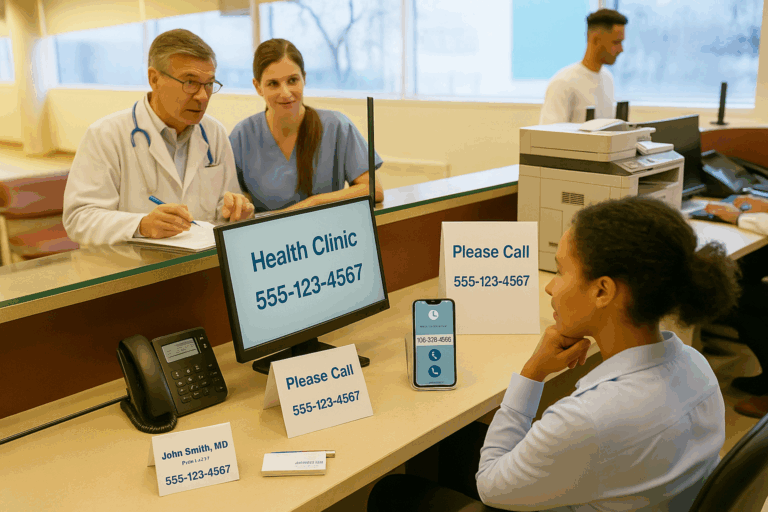Front office staff at healthcare practices are responsible for much more than making a positive first impression on patients. They’re tasked with scheduling and rescheduling appointments, collecting patient data, verifying insurance information, procuring payer approval for care, resolving billing issues and much more. That doesn’t even include answering the average of 53 daily phone calls a typical practice receives.
Primary care physician practices in the United States receive an estimated 150 to 300 phone calls per week, only about half of which are for clinical issues. This doesn’t include calls from pharmacies, drug reps, other doctors’ offices and insurance companies. In fact, fewer than 10 percent of primary care calls require escalation to physicians, and fewer than five percent require triage to the emergency department (ED).
Even when your front office staff is simply answering a patient’s call to schedule an appointment, it can be time-consuming. Why? Because it takes an average of eight minutes for a patient to schedule an appointment over the phone.
Meeting Patient Preferences
With the rise of healthcare consumerism, many patients prefer online scheduling. However, almost half of patients still prefer to schedule appointments with their healthcare provider over the phone.
Just because patients prefer to use a phone call to reach your office, though, doesn’t mean they like to spend a lot of time doing it. Callers sitting on hold for long periods markedly decreases patient satisfaction. New patients who call often are unlikely to leave a message with your practice or call back to schedule an appointment.
Similarly, physician practices that lack proper phone management systems often experience unnecessary stress when handling incoming calls. Perhaps that’s because patient calls are transferred 63 percent of the time.
Communication problems are so prevalent in healthcare that the Agency for Healthcare Research and Quality (AHRQ) lists them as one of the eight common root causes of medical errors. Conversely, there are myriad advantages effective communication in healthcare produces, including:
- Improved quality of care
- Enhanced patient experience
- Reduced cost of care
- Improved patient satisfaction scores
- Decreased stress and burnout for clinicians
- Reduced complaints and readmissions
- Improved staff teamwork and collaboration
One of the best ways to minimize patient on-hold times while improving practice staff satisfaction and productivity is to utilize a call routing practice. It streamlines your medical practice’s communication flow by efficiently managing incoming calls. Call routing ensures patients can easily reach the right provider to handle their requests and route calls based on staff responsibilities.
When call routing is used correctly, patients with urgent medical needs are quickly connected to live support staff. At the same time, those with routine questions are transferred to the team member best suited to answer them or the appropriate voicemail box. This helps reduce medical errors responsible for 100,000 to 200,000 deaths annually.
Call routing also reduces manual call transfers. Staff then has more time to focus on other pertinent tasks, and patient and front office satisfaction increases.
Not All Communications Systems are Created Equal
Communications systems for healthcare range from simple to feature-rich. Some are cloud-based, while others consist of on-premise telephone boxes that require substantial capital investment. Healthcare practices that use outdated communications technology often deal with problems such as:
- The inability to quickly respond to patient calls
- Delays and breakdowns in vital communication between medical staff (which can compromise the quality of care delivered)
- Interruptions to workflow due to factors such as increased phone system downtime
- Increased financial waste due to unnecessary capital expenditures and reduced productivity of staff
A well-designed cloud-based healthcare communications system leverages multiple technologies — desk and mobile phones, web and manual faxing and voicemail inboxes — for a HIPAA-compliant system built to fit the specific needs of your practice. For example, you can employ desk phones for your front-office receptionists, medical billers, and mobile devices for your practice’s clinicians. Or, you can transfer calls from a desk phone to a mobile one to enable your physicians to receive calls after business hours.
The RingRx HIPAA-compliant VoIP phone system can streamline your practice’s communication processes and reduce operational costs. No more monthly hardware fees or frequent software updates necessary!
Our system helps you better manage large volumes of calls and messages, ensuring nothing slips between the cracks. As an enterprise-quality phone system, it also includes easy-to-implement advanced call routing features like Auto Attendant, Ring Groups, Parking Lot, Call Queues and Call Pickup.
Start your free trial of RingRx today to learn how call routing can enhance the communications experience of patients and staff!




